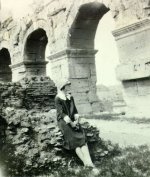
A Guggenheim Fellow in Europe during the Golden Years of Physics (1926-1927)
1926
On March 4, Linus and Ava Helen Pauling take a train to Chicago, where they arrive on March 7 and see her father. Then they proceed to Buffalo, where they take a side trip to Niagara Falls. They arrive in New York City on March 9.
On March 9, they sail aboard the Duilio across the Atlantic Ocean. They enjoy shore trips, at Madeira, Gibraltar, and Algiers, before arriving at Naples on March 23. They spend the rest of March and the first three weeks of April sightseeing in Italy (Mt. Vesuvius, Pompeii, Rome, Florence, Pisa, Fiesole, and Venice). They arrive in Munich, Germany on April 20. Pauling begins work at Arnold Sommerfeld’s Institute for Theoretical Physics at the University of Munich.
During the summer, Pauling attends a conference on magnetism in Zürich where he meets Wolfgang Pauli, Peter Debye, and several other physicists. Linus and Ava Helen take a holiday vacation, traveling in Switzerland, France, and Germany.
Pauling’s mother dies on July 12 in a hospital in Salem, Oregon, but he does not receive news about it until the end of July (in a letter from his sister Lucile).
In the late summer, Pauling discovers an error in a paper by Gregor Wentzel about the structure and properties of atoms with many electrons. This gets Pauling interested in screening constants (the ability of inner electrons to shield the nuclear charge from outer electrons). He submits a paper on the wave mechanics of penetrating orbits to the Zeitschrift für Physik on October 27.
In December, Pauling applies for a renewal of his Guggenheim Fellowship (he wishes to spend the summer semester of 1927 with Erwin Schrödinger in Zürich).
1927
Pauling applies his theory of screening constants to various problems—electric polarizability, diamagnetic susceptibility, and the sizes of ions and atoms. This results in one of his greatest papers: "The Theoretical Prediction of the Physical Properties of Many-Electron Atoms and Ions. Mole Refraction, Diamagnetic Susceptibility, and Extension in Space." Sommerfeld submits this paper on behalf of Pauling to the Proceedings of the Royal Society (London) at the beginning of 1927.
Pauling receives a letter from G.N. Lewis, who makes it clear that he has a job for Pauling at Berkeley if he wants it, but Pauling has already made a commitment to Noyes to return to CIT.
On March 22, Pauling is awarded a renewal of his Guggenheim Fellowship.
On April 21, Pauling and Ava Helen arrive at Copenhagen, Denmark, where he spends a month at Niels Bohr’s Institute for Theoretical Physics. He sees very little of Bohr and spends his time on quantum mechanical calculations of the chemical bond. He meets Samuel A. Goudsmit and begins to collaborate with him.
In June, the Paulings return to Munich via Göttingen, where they meet J. Robert Oppenheimer.
In July and part of August, Pauling works at the University of Zürich, where he attends Schrödinger’s seminars once a week but is unable to see him personally (Schrödinger is not interested in his work). Pauling has fruitful conversations with Walter Heitler and Fritz London.
On August 10, Linus and Ava Helen travel to Paris for a few days, and then, after two weeks in England (where Pauling spends some time with William Henry Bragg on a visit to the Royal Institution), the Paulings sail on the George Washington on the first of September for New York. They then travel by train to Portland, where they pick up Linus Pauling, Jr. Because Ava’s mother has kept the memory of his parents vividly alive, he remembers both of them.
Table of Contents
- The Ancestry of Linus Pauling (The Paulings)
- The Ancestry of Linus Pauling (The Darlings)
- Linus Pauling's Childhood (1901-1910)
- Linus Pauling's Adolescence (1910-1917)
- Pauling's Years as an Undergraduate at Oregon Agricultural College, Part 1 (1917-1919)
- Pauling's Years as an Undergraduate at Oregon Agricultural College, Part 2 (1919-1922)
- Linus Pauling as a Graduate and Postdoctoral Student at the California Institute of Technology, Part 1 (1922-1923)
- Linus Pauling as a Graduate and Postdoctoral Student at the California Institute of Technology, Part 2 (1924-1926)
- A Guggenheim Fellow in Europe during the Golden Years of Physics (1926-1927)
- Early Career at the California Institute of Technology (1927-1930)
- Pauling's Great Years of Achievement in Structural Chemistry, Part 1 (1931-1932)
- Pauling's Great Years of Achievement in Structural Chemistry, Part 2 (1933-1935)
- Pauling's Increasing Involvement in Molecular Biology (1936-1939)
- The War Years, Part 1 (1940-1942)
- The War Years, Part 2 (1943-1945)
- The Postwar Years, Part 1 (1946-1947)
- The Postwar Years, Part 2 (1948-1949)
- Proteins, Passports, and the Prize (1950-1954)
- Increasing Involvement in World Peace, Part 1 (1955-1958)
- Increasing Involvement in World Peace, Part 2 (1959-1963)
- The Center for the Study of Democratic Institutions (1964-1967)
- The University of California, San Diego (1968-1969)
- Stanford University (1969-1972)
- An Institute for Science and Orthomolecular Medicine, Part 1 (1973-1977)
- An Institute for Science and Orthomolecular Medicine, Part 2 (1978-1981)
- The Years Alone: Pauling after the Death of Ava Helen, Part 1 (1982-1988)
- The Years Alone: Pauling after the Death of Ava Helen, Part 2 (1989-1994)
- About the Author


